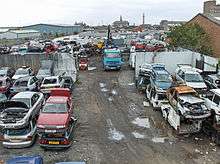Vehicle recycling

Vehicle recycling is the dismantling of vehicles for spare parts. At the end of their useful life, vehicles have value as a source of spare parts and this has created a vehicle dismantling industry. The industry has various names for its business outlets including wrecking yard, auto dismantling yard, car spare parts supplier, and recently, auto or vehicle recycling. Vehicle recycling has always occurred to some degree but in recent years manufacturers have become involved in the process. A car crusher is often used to reduce the size of the scrapped vehicle for transportation to a steel mill.
Approximately 12-15 million vehicles reach the end of their use each year in just the United States alone. These automobiles, although out of commission, can still have a purpose by giving back the metal and other recyclable materials that are contained in them. The vehicles are shredded and the metal content is recovered for recycling, while in many areas, the rest is further sorted by machine for recycling of additional materials such as glass and plastics. The remainder, known as automotive shredder residue, is put into a landfill. The shredder residue of the vehicles that is not recovered for metal contains many other recyclable materials including 30% of it as polymers, and 5-10% of it as residual metals. Modern vehicle recycling attempts to be as cost-effective as possible in recycling those residual materials.[1] Currently, 75% of the materials are able to be recycled. As the most recycled consumer product, end-of-life vehicles provide the steel industry with more than 14 million tons of steel.[2]
Process

The process of recycling a vehicle is extremely complicated as there are many parts to be recycled and many hazardous materials to remove. Briefly, the process begins with incoming vehicles being inventoried for parts. The wheels and tires, battery and catalytic converter are removed. Fluids, such as engine coolant, oil, transmission fluid, air conditioning refrigerant, and gasoline, are drained and removed. Certain high value parts such as electronic modules, alternators, starter motors, infotainment systems - even complete engines or transmissions - may be removed if they are still serviceable and can be profitably sold on; either in "as-is" used condition or to a remanufacturer for restoration. Other hazardous materials such as mercury, and sodium azide (the propellant used in air bags) may also be removed.[3] After all of the parts and products inside are removed, the remaining shell of the vehicle is sometimes subject to further processing, which includes removal of the air conditioner evaporator and heater core, and wiring harnesses. The remaining shell is then crushed flat, or cubed, to facilitate economical transportation in bulk to an industrial shredder or hammer mill, where the vehicles are further reduced to fist-sized chunks of metal. Glass, plastic and rubber are removed from the mix, and the metal is sold by multiple tons to steel mills for recycling.[3][4]
Benefits
Recycling steel saves energy and natural resources. The steel industry saves enough energy to power about 18 million households for a year, on a yearly basis. Recycling metal also uses about 74 percent less energy than making metal. Thus, recyclers of end-of-life vehicles save an estimated 85 million barrels of oil annually that would have been used in the manufacturing of other parts.[2] Likewise, car recycling keeps 11 million tons of steel and 800,000 non-ferrous metals out of landfills and back in consumer use.[4] Before the 2003 model year, some vehicles that were manufactured were found to contain mercury auto switches, historically used in convenience lighting and antilock braking systems. Recyclers remove and recycle this mercury before the vehicles are shredded to prevent it from escaping into the environment. In 2007, over 2100 pounds of mercury were collected by 6265 recyclers.[2]
Recycling one car saves 1.25 tons of iron ore, 1400 pounds of coal and 120 pounds of limestone, 13/14 tons of steel, 39,090 gallons of water
Policies

European Union
In 1997, the European Commission adopted a Proposal for a Directive which aims at making vehicle dismantling and recycling more environmentally friendly by setting clear targets for the recycling of vehicles. This proposal encouraged many in Europe to consider the environmental impact of end-of-life vehicles. In September 2000, the End of Life Vehicles Directive was officially adopted by the EP and Council. Over the next decade, more legislation would be adopted in order to clarify legal aspects, national practices, and recommendations.[5]
A number of vehicle manufacturers collaborated on developing the International Dismantling Information System to meet the legal obligations of the End of Life Vehicles Directive.
United States
On July 1, 2009 and the next 55 days, the Car Allowance Rebate System, or “Cash for Clunkers”, was an attempt at a green initiative by the United States Government in order to stimulate automobile sales and improve the average fuel economy of the United States. Many cars ended up being destroyed and recycled in order to fulfill the program, and even some exotic cars were crushed.[6] Ultimately, as carbon footprints are of concern, some will argue that the “Cash for Clunkers” did not reduce many owners’ carbon footprints. A lot of carbon dioxide is added into the atmosphere to make new cars. It is calculated that if someone traded in an 18 mpg clunker for a 22 mpg new car, it would take five and a half years of typical driving to offset the new car’s carbon footprint. That same number increases to eight or nine years for those who bought trucks.[7]
If a vehicle is abandoned on the roadside or in empty lots, licensed dismantlers in the United States can legally obtain them so that they are safely converted into reusable or recycled commodities.[2]
Facts
- The typical passenger car consists of about 65 percent steel and iron, by weight. Also, car bodies typically are made 25 percent of recycled steel.[2]
- Recycling one ton of steel conserves 2500 pounds of iron ore, 1400 pounds of coal and 120 pounds of limestone.[2]
- Approximately 10 million vehicles are recycled annually.[4]
- Cars are the number one recycled product in the United States.
See also
References
- ↑ "Vehicle Recycling". 16 September 2008. Archived from the original on 16 February 2013. Retrieved 21 May 2012.
- 1 2 3 4 5 6 "Benefits of Recycling Car Bodies". Archived from the original on 17 February 2014. Retrieved 21 May 2012.
- 1 2 "You Auto Recycle - A Guide for Vehicle Recycling". Retrieved 21 May 2012.
- 1 2 3 "Recycle". Retrieved 21 May 2012.
- ↑ Waste - Environment - European Commission
- ↑ Ten Most Exotic Cars Destroyed By Cash For Clunkers
- ↑ Critics Say 'Clunkers' Program Isn't Very Green : NPR
External links
| Wikimedia Commons has media related to Automobile scrap yards. |
- End of Life Vehicles page at the European Commission
- End of Life Vehicle Solutions (United States)
- Motor Vehicle Dismantlers Association (United Kingdom) - Vehicle Recycling & the environment
- The European Umbrella Association for Automotive Recyclers European Group of Automotive Recycling Associations
- The Romanian Association for Automotive Dismantlers ANSDAR
- Vehicle Recycling Partnership (United States) - part of the United States Council for Automotive Research
